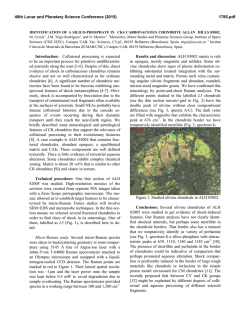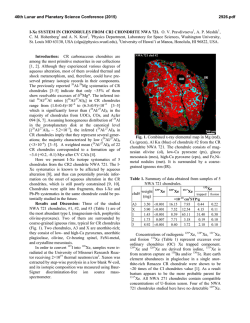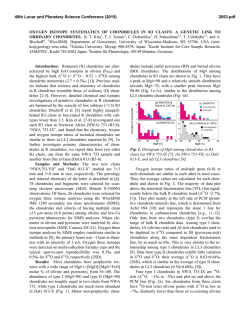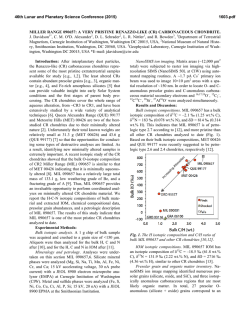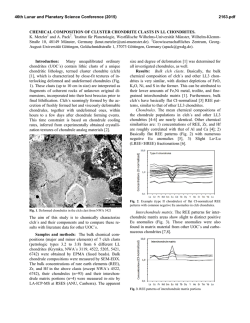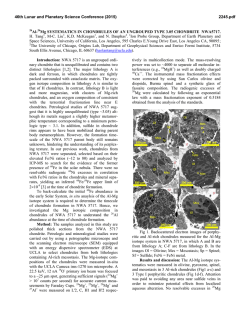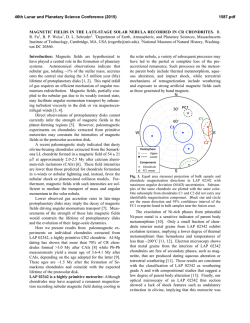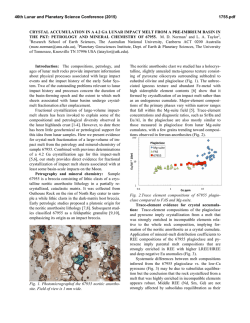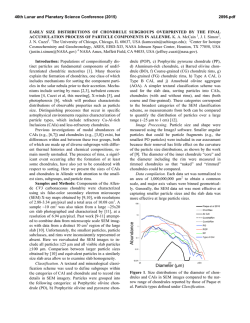
A New Unequilibrated Chondrite Lithology Discovered in the
46th Lunar and Planetary Science Conference (2015) 1143.pdf A NEW UNEQUILIBRATED CHONDRITE LITHOLOGY DISCOVERED IN THE MURCHISON CM2 METEORITE G.K. Benedix1,2, S.S. Russell3, L.V. Forman1, A.W.R. Bevan2, and P.A.Bland1,2, 1Dept of Applied Geology, Curtin Univeristy, GPO Box U1987A, Perth, Western Australia, 6845 Australia ([email protected]), 2Western Australian Museum, Locked Bag 49, Welshpool, WA, 6986, Australia, 3 Department of Earth Sciences, Natural History Museum, Cromwell Road, London, SW7 5BD, U.K Introduction: The Murchison meteorite fell in Victoria, Australia in 1969 and is probably the most studied CM2 meteorite because of the amount of material available (~100kg in a number of stones) as well as the fact that it is a fall [1]. The major texture of the meteorite is dominated by a fine-grained matrix of aqueously altered minerals in which chondrules and CAIs are heterogeneously distributed [1 and references therein]. In addition, it was one of the first meteorites from which organics were reported [2]. The first comprehensive study of Murchison [3], noted the occurrence of four types of inclusion distributed through the dark, fine-grained matrix material; A) fragments or whole single mineral crystals, B) ‘white inclusions’ (probably CAIs and/or partly characterised phases), C) chondrules, and D) fragments of xenoliths. The fragmental xenoliths were described as being lighter in color and ranging in size up to 13mm. It was suggested that they represent a ‘unique kind of C3 chondrite’[3], containing mostly troilite and pentlandite with little to no metal or ‘true’ chondrules. The main ‘mass’, consisting of many stones comprising 65kg of Murchison was acquired through private sale by the Field Museum of Natural History in Chicago. A 691.7g, nearly complete, crusted individual was exchanged with the Western Australian Museum (WAM 13323) by the FMNH (through Ed Olsen) in 1974. One end of the stone was cut and two thin sections were made. Upon recent detailed examination, the texture of one of the thin sections (WAM13323-1) was found to be completely unlike normal Murchison and, further, does not seem to be one of the xenolithic inclusions described by [3]. We present here analytical data on this new textural/chemical lithology in Murchison that is best described as an ungrouped, unequilibrated chondrite. Analytical techniques: Mineral compositions were determined using a JEOL 8530F microprobe at the University of Western Australia Centre for Microscopy, Characterisation, and Analysis (CMCA). High resolution quantitative maps were acquired on the same system. Operating conditions for mineral analyses were 20kv and 20nA; for imaging, the beam current was 80nA. Low resolution back-scatter and element maps of the entire thin section (measuring 15.7 x 40 mm) were obtained on the Tescan Mira3 FESEM in the John de Laeter Centre (JdLC) of Isotope Studies at Curtin Uni- versity. Operating conditions were 20kv and a beam intensity of 10. Results and Discussion: The thin section has an unequilibrated chondritic texture and is dominated by whole and broken chondrules ranging in size from <150 to >1500 µm in diameter (Fig. 1) dispersed amongst broken bits of anhydrous mineral crystals. Olivine shows slight undulatory extinction in a number of different chondrules, indicating low shock levels across the section. Metal (both Ni-rich and poor) and sulfide are heterogeneously distributed across the thin section. Several chondrules have sulfide rims. Modally, sulfide and metal are ~8 and ~3 vol%, respectively. The metal content falls within the LL-type ordinary chondrites (OC) range, but the sulfide/metal ratio is higher than H and L, and lower than LL. There is no evidence for pentlandite in the section. A random sampling of 12 olivine grains from seven chondrules gives an average Fa value of 23.0 ± 1.7, with a variance of 2.9. If the minimum (17.7) and maximum (24.1) Fa values are removed, the average value of the remaining grains is 23.4 ± 0.02 with a variance of 0.05. This value falls in the range for L chondrites. However, the pyroxene and plagioclase compositions are not so diagnostic. Analysis of 13 pyroxenes from 7 chondrules reveals 8 high-Ca pyroxene with a mean value of Fs7±4Wo44±4; the 5 low-Ca pyroxenes have a mean value of Fs13±2Wo8±6 (Fig. 2). The variance for these analyses is significantly larger than for olivine and is more consistent with the unequilibrated texture. In most unequilibrated (type 3) ordinary chondrites, plagioclase is a rare phase; where found it is typically anorthositic [e.g. 4]. In thin section WAM 13323-1, plagioclase is abundant; compositions of 27 grains in 8 chondrules span the range from nearly pure anorthite to virtually pure albite (Fig. 3). In our preliminary examination, Na-rich plagioclase compositions occur in 5 different chondrules or chondrule fragments. These overlap with all mean OC plagioclase compositions. Finally, a few grains of Cr-poor spinel were found with compositions roughly between spinel (MgAl2O4) and hercynite (FeAl2O4). Fe-rich spinel can be an indicator of parent body metamorphism [5], but seems unlikely in this sample given the highly unequilibrated silicates.. Spinel is more common in carbonaceous chondrites (CC) than OC, where it is more likely to be in the form of chromite. 46th Lunar and Planetary Science Conference (2015) Conclusions: This sample appears to be a rather large unequilibrated chondritic xenolith found in the Murchison meteorite. Based on the above information, it does not fit Fuchs’ [3] description of a unique C3 type (no metal, rare chondrules, lots of sulfide/pentlandite) found in Murchison previously and, thus, is a new xenolith type that has not been sampled before. It has affinities to both OC and CC, as well as features that are not indicative of any known chondritic groups. The paucity of matrix may rule out any similarity to C types. The olivine and pyroxene compositions are contradictory. The plagioclase compositions span the whole range of ordinary and carbonaceous chondrites. Based on this current work, we consider this to be an ungrouped Type 3 chondritic rock. Future work: Of note in the large area element maps were several small (~300 µm diameter) Na-rich, Ca-poor chondrules. These are the source of the albitic compositions reported above. We will study these in detail to determine how they formed and what they might mean for chondrule formation theories. We will use electron backscatter diffraction (EBSD) to ascertain the mineralogy of these Na-rich chondrules as well as quantify the level of shock in the meteorite. We will also explore the relationship of this lithology to the rest of Murchison by analyzing the oxygen isotopic compositions of the minerals. Acknowledgments: We thank Dr. Malcolm Roberts for help with the quantitative mapping at the CMCA. References: [1] Hutchison R. (2004) Meteorites: A Petrologic, Chemical, and Isotopic Synthesis. Cambridge University Press, 506pp. [2] Kvenvolden, K. et al. (1970) Nature, 228, 923-926. [3] Fuchs et al. (1973) Smithsonian Contrib. to Earth Sci., 10. [4] Huss et al. 1143.pdf (2001) 36 975-997 [5] Russell et al. (1998) Geochimica et Cosmochimica Acta 62 689-714. Wo Murchison_ Unknown H L LL 50 50 25 En 25 25 50 75 Fs Figure 2. Pyroxene quadrilateral diagram showing compositional range in Murchison unknown. Average compositions of equilibrated ordinary chondrite low-Ca pyroxenes are also shown. Data for OC from [1]. Figure 3. Plagioclase ternary diagram illustrating the range of plagioclase compositions. Average compositions of plagioclase in equilibrated ordinary chondrites are also shown. Data for OCs from [1] Figure 1. Backscattered electron image showing unequilibrated texture of new xenolith from Murchison meteorite.
© Copyright 2026
